
As chiropractors, we all seek out strategies to: get patients better
faster, encourage an active role in patient care, increase earnings, and
make efficient use of our time and hands-on work when treating
patients.
As chiropractors, we all seek out strategies to: get patients better faster, encourage an active role in patient care, increase earnings, and make efficient use of our time and hands-on work when treating patients.
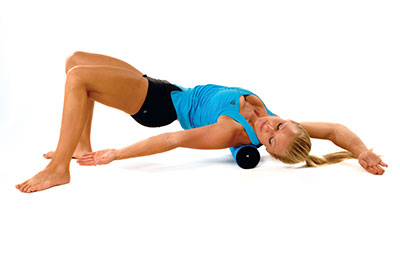 |
|
In Canada’s health-care system, we are musculoskeletal (MSK) experts. As leaders in MSK treatment, we need to be on the forefront of what our patients are doing and be ready to guide them safely and properly in their endeavors.
One strategy that is gaining traction in patient care and injury management is foam rolling. The following is a basic overview of the foam rolling technique. The goal is to clarify the details surrounding foam rolling and assist chiropractors in introducing this technique with confidence in the clinical setting.
A foam roller is a cylindrical tube of foam. They come in many sizes, lengths, materials and textures. Traditionally, they were uniform tubes of foam. Today, some have hollow cores and contoured designs and come in various lengths and diameters.
Foam rolling involves self-massage, whereby the muscle is compressed and trapped by two hard surfaces (bone and the foam roller), while the foam roller is maneuvered to produce a massage effect.
Three primary elements are being addressed when foam rolling: tight muscles, strained muscles and inhibited muscles. The self-massage does an excellent job of releasing tight muscles, which are typically associated with dysfunction and compensation. Proper, effective rolling also works well for releasing strained muscles and restoring function to muscles that are inhibited due to the process of motor inhibition (autogenic inhibition), often associated with muscle strain and excessive muscle tightness.
If foam rolling can release a muscle to normalize the tone and texture of a muscle, reduce or eliminate pain and/or restore motor function, this is what we call a physiological or therapeutic effect. To clarify: just because you roll does not mean you get the desired effect and release the tight, strained or inhibited muscles.
To successfully roll and achieve the desired therapeutic effect to release and uninhibit muscles, there are three equally important variables: technique, body position and foam roller. If any of these variables are insufficient then the therapeutic outcome will be compromised.
Technique
The Roll Release Foam Roller Technique was developed to standardize foam rolling and ensure there is consistency within foam rolling. This systematic technique is an isolated segmental foam rolling technique. It allows the person rolling to have the greatest amount of control and get the greatest amount of depth into the muscle, which achieves the best therapeutic effect.
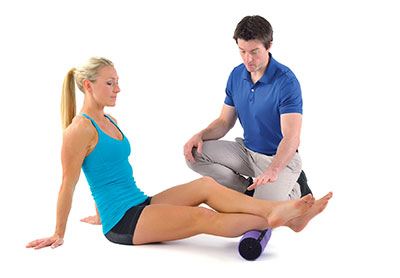 |
|
| Dr. Ryan Emmons instructs patients on foam rolling of the calf muscle
|
To understand the technique: envision a line down a muscle and divide the line into segments that are between one and four inches in length, whereby the shorter the segment the deeper the release. Each muscle will have varying numbers of segments based on the complete/entire muscle length and width and segment lengths.
Each segment is rolled in a steady back and forth movement for five to 10 seconds. The rolling protocol can be repeated two to three times through a muscle. The segments can be rolled longer; however, there is a threshold of tolerance per segment in a muscle and by the person rolling. This is a guideline for safe rolling to ensure the person rolling does not overdo it and irritate the muscle.
Body position
The body position will ensure that the foam roller contacts flush against the muscle. It will also take into account safety of the body to avoid compromising shoulder, neck and low back positions. The foam roller will be placed perpendicular to the muscle to adequately trap the muscle while the rolling movement is performed.
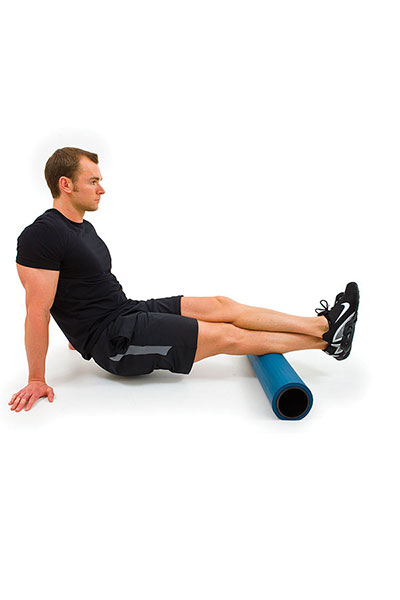 |
|
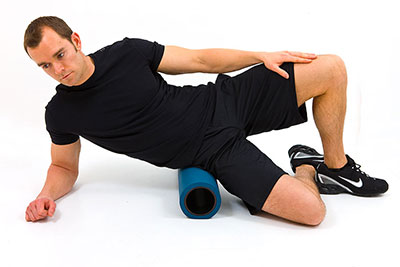 |
|
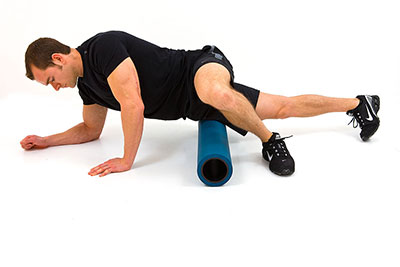 |
|
| Various foam rolling techniques for calves (top) gluteus minimus muscle (middle) and outer thigh (bottom)
|
Foam roller
This variable is just as important but equally ineffective when not used appropriately. I personally have found only one foam roller that truly does the job well. That said, other foam rollers could work for your patients. Please do not be misled by the rollers with the bumps and designs on them; they look good, but in reality they do not allow for proper technique and safe rolling of muscles for the desired physiological effect. Further, it is about being therapeutic, not aggressive. If a muscle is responsive, aggressive foam rolling is inappropriate and can be traumatic to the tissue.
Frequency
Most patients would benefit from daily rolling. When working intensely to correct an issue it is quite common to have someone rolling two to three times per day for short periods of time.
Duration
The length of time you roll will all depend on the number and size of muscles rolled. Based on the five seconds per segment method, working twice through a muscle, the average muscle is rolled for 30 to 60 seconds.
Intensity
Pain is a common complaint when people explain why they avoid foam rolling. This is commonly due to the fact that they are rolling incorrectly and not rolling to their tolerance. Often, they have been shown an aggressive version of rolling for the muscle they wish to release. This is the challenge with YouTube and other sources of foam rolling videos.
There are at least five to 10 body positions to roll each muscle, which allows the practitioner to tailor it to the patient’s needs and tolerance. This is vital to ensure the patient relaxes while rolling and to keep them compliant.
The proper technique will provide control of the body to alleviate the amount of pressure applied to the muscle, and the body position should be suitable to their tolerance so the patient can reduce the pressure when necessary.
Clinic integration
Patients are often quite open to new techniques and trust their practitioners. The goal is to keep it simple but logical. The best strategy is to teach one or two rolling techniques per visit to avoid overwhelming the patient. It is also important to review how they roll once they have practiced.
It can be beneficial to hold foam rolling workshops or schedule appointments for instruction if your patients require more time and information.
Incentives
There are a number of incentives for chiropractors to integrate foam rolling into the clinic setting. Among them: financial incentives through foam roller sales, workshops and instruction appointments; time efficiency incentives based on less time and hands-on work required per treatment; reputation incentives reinforcing your expertise in MSK treatment which subsequently increases patient retention and referrals; outcome incentive, as foam rolling can support and improve your treatment outcomes in a shorter period of time; and connection incentives, providing an opportunity to connect with potential patients in a non-intimidating environment.
Don’t fear the roller
Practitioners sometimes voice a concern that the foam roller will take the place of treatment and encourage people to not return for subsequent treatments. The most common reason patients don’t return is that they are not getting results – not because they were taught to use a foam roller on their own.
It is quite interesting how the success from rolling is actually often attributed to the practitioner because they prescribed the rolling technique. The practitioner must educate the patient that foam rolling is complementary to their care and never takes the place of chiropractic treatment. For example, a foam roller cannot treat joint restrictions, nor can it release a psoas muscle. The patient will also require your expert advice and guidance throughout the recovery process to progress and completely resolve the problem.
There will always be a necessity for treatment. The foam roller allows the patient to play an active role in their care and helps to speed up the time for recovery from an injury or in restoring function to the body. It offers practitioners greater control over the desired outcome while the patient is under their care by managing the influence of other factors away from treatment.
The ultimate goal is to help patients get better. When patients perceive improvement, it increases retention and referrals. When we take the position of a “guide” in patient care it will open up a whole new realm of possibilities. Foam rolling supports us in this process and in securing our position as MSK experts.

|
|
Dr. Ryan Emmons, DC, is the author of the Roll Release Foam Roller Techniques books and ebooks and developer of the Roll Release Foam Roller System of workshops, seminars and certifications. Contact him at info@rollrelease.com.
Print this page